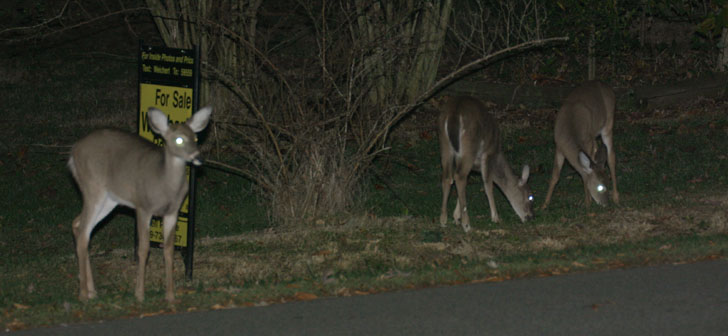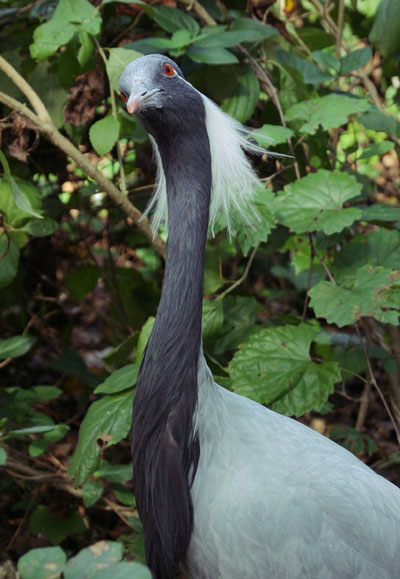 And so, our saga resumes where it left off, with our heroes trapped within the confines of a completely non-treacherous and non-threatening bird park…
And so, our saga resumes where it left off, with our heroes trapped within the confines of a completely non-treacherous and non-threatening bird park…
As I mentioned before, Sylvan Heights Bird Park provides great opportunities for close encounters, and to the photographer, the urge to do personal portraits of the birds is practically irresistible. I found myself breaking my own personal rule, however, which is to avoid direct portraits and try instead to include more setting and interest within the frame – in other words, not to make the subject quite so dominant, like the Demoiselle Crane (Anthropoides virgo) seen here, but instead part of a scene. In my defense (remembering what was on my mind at the time,) this is often hard to do with subjects that wander at will and don’t take direction too well, and one’s attention tends to concentrate on focus, light, and the poses of the birds. I know I spend no small amount of time, in situations like this, waiting for the critter to turn their head just right to get a nice catchlight in the eyes, a bright reflection that adds a lot to the character and “life” of the animal. Many animals prefer not to blind themselves and so don’t pose where sunlight is directly hitting their eyes too often, the selfish gits.
As it is with most zoos, you take the opportunities that you have, and plan to return later on to reap a whole different set of images, when particular animals are more accessible, and when plumage and light conditions are different. In this way you build a wide portfolio of images from any one location. There’s also the interesting concept of getting used to the species, knowing you already have several frames of simple portraits, and so subsequent trips means that you try for something more creative, artistic, expressive, and so on. For instance, I got spoiled on Great Blue Herons in Florida, where close approaches are surprisingly easy at times, so I almost ignore them here in North Carolina where I cannot get within twenty meters of one.
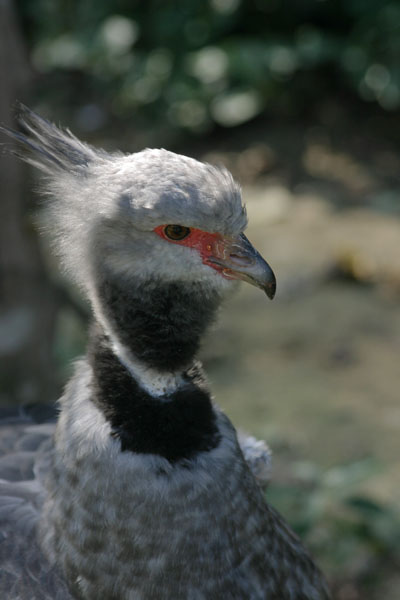 I’ve spoken before about exposure compensation, and in situations like this, knowing how to exploit it almost automatically will help produce much better results. We were in sunny, high contrast conditions, which can be hard to work with in the first place, because cameras (film or digital) tend to capture very narrow ranges of light, so on days when the ranges are wide, it’s easy to fall outside the envelope and lose detail in either bright or shadowed areas, sometimes both. At the same time, a large variety of multi-colored subjects often challenges the exposure logic within cameras. Is the camera obtaining its light reading, and thus setting “proper” exposure, off of the white feathers, or the black? Or even the background? I was delighted to finally see a Crested Screamer (Chauna torquata) in person, having read about them in The Drunken Forest by Gerald Durrell, but I have other frames where the sunlit crest feathers are overexposed and lose all detail in the glare. It’s possible to get a general ambient light reading, with an external meter or by aiming the camera at a good midtone, and use those settings on manual exposure throughout, but this would need to be done for all light conditions throughout your shoot, and with birds turning into and away from the light, it’s usually easier to adjust exposure compensation back and forth a bit, bracketing as needed. I always caution people that the preview image provided by the LCD is a truly horrible way to judge exposure, but with a lot of experience and comparison, it can provide a rough judgment. The same may be said for using histograms – birds with white feathers will naturally provide some peaks in the highlights, but how much is too much?
I’ve spoken before about exposure compensation, and in situations like this, knowing how to exploit it almost automatically will help produce much better results. We were in sunny, high contrast conditions, which can be hard to work with in the first place, because cameras (film or digital) tend to capture very narrow ranges of light, so on days when the ranges are wide, it’s easy to fall outside the envelope and lose detail in either bright or shadowed areas, sometimes both. At the same time, a large variety of multi-colored subjects often challenges the exposure logic within cameras. Is the camera obtaining its light reading, and thus setting “proper” exposure, off of the white feathers, or the black? Or even the background? I was delighted to finally see a Crested Screamer (Chauna torquata) in person, having read about them in The Drunken Forest by Gerald Durrell, but I have other frames where the sunlit crest feathers are overexposed and lose all detail in the glare. It’s possible to get a general ambient light reading, with an external meter or by aiming the camera at a good midtone, and use those settings on manual exposure throughout, but this would need to be done for all light conditions throughout your shoot, and with birds turning into and away from the light, it’s usually easier to adjust exposure compensation back and forth a bit, bracketing as needed. I always caution people that the preview image provided by the LCD is a truly horrible way to judge exposure, but with a lot of experience and comparison, it can provide a rough judgment. The same may be said for using histograms – birds with white feathers will naturally provide some peaks in the highlights, but how much is too much?
To the park’s credit, it is often possible to work multiple sides of the aviary or pond areas, and thus exploit the light conditions a little more. Provided, of course, that one can convince the birds to cooperate. This is where spending a little time, coming back through the same areas, and returning to the park on other days comes in handy.
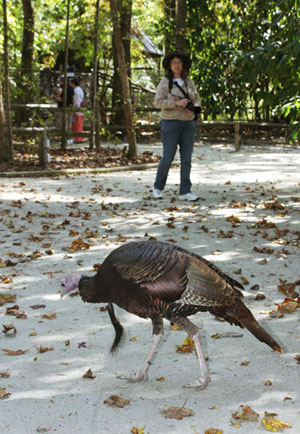 At one point we noticed a local native Wild Turkey (Meleagris gallopavo) hanging out on the outside of the peacock cage, who was only mildly anxious at our approach. A little later we questioned a park worker, who informed us that it was actually a wild fowl, not a park resident, who had taken a shine to the peacocks and turned stalker. I admit to being a little curious over this, since both the peacock and the turkey were males, but I’ve seen territorial disputes between caged and wild birds before, and this situation didn’t have that appearance. (I digress for a brief anecdote: Many years ago while visiting a wildlife refuge in Florida, I saw my first Pileated Woodpeckers, surprisingly large birds, and then checked out the nearby rehabilitation clinic. There, an unreleasable captive who’d had a wing amputation would get apoplectic over a wild visitor, who would periodically sit on the timbers right outside the captive’s fence and beat a territorial drumming, well aware that the resident inside could do nothing about it. And you thought only humans could be sadistic…)
At one point we noticed a local native Wild Turkey (Meleagris gallopavo) hanging out on the outside of the peacock cage, who was only mildly anxious at our approach. A little later we questioned a park worker, who informed us that it was actually a wild fowl, not a park resident, who had taken a shine to the peacocks and turned stalker. I admit to being a little curious over this, since both the peacock and the turkey were males, but I’ve seen territorial disputes between caged and wild birds before, and this situation didn’t have that appearance. (I digress for a brief anecdote: Many years ago while visiting a wildlife refuge in Florida, I saw my first Pileated Woodpeckers, surprisingly large birds, and then checked out the nearby rehabilitation clinic. There, an unreleasable captive who’d had a wing amputation would get apoplectic over a wild visitor, who would periodically sit on the timbers right outside the captive’s fence and beat a territorial drumming, well aware that the resident inside could do nothing about it. And you thought only humans could be sadistic…)
Situated in the transition area between cotton fields and wetlands, the park creators exploited this a bit and put in two other attractions: an observation blind over a beaver pond, and a “treehouse” gazebo on stilts over a wetland expanse. It was unfortunately the wrong time of year for either, but I imagine they’re great observation areas in the spring (we will, hopefully, find out.) There are also a couple of tanks of poison dart frogs, and a honeybee hive with a glass side. The main building offers a gift shop and some kids’ activities, though it appears the best opportunities come through their scheduled learning programs.
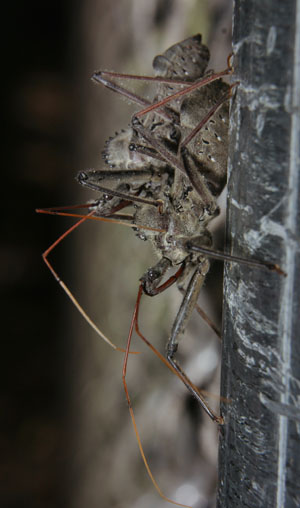 Despite my desire for some different subject matter on this trip, I yielded to temptation when I found a pair of Wheel Bugs (Arilus cristatus,) a variety of assassin bug, mating on a fence post. Their piercing proboscises, for draining the insides from the other insects that make up their food, are plainly visible from this angle. This past year has been almost entirely dedicated to bug shots, without my intentions – I’ve simply been unable to do enough traveling to provide opportunities for other subjects, and have been milking the local area for everything I can. I probably should begin a bobcat or fox portfolio project…
Despite my desire for some different subject matter on this trip, I yielded to temptation when I found a pair of Wheel Bugs (Arilus cristatus,) a variety of assassin bug, mating on a fence post. Their piercing proboscises, for draining the insides from the other insects that make up their food, are plainly visible from this angle. This past year has been almost entirely dedicated to bug shots, without my intentions – I’ve simply been unable to do enough traveling to provide opportunities for other subjects, and have been milking the local area for everything I can. I probably should begin a bobcat or fox portfolio project…
Species breeding programs, like the ones this park is built around, actually accomplish an astonishing amount. Numerous species that were on the brink of extinction have recovered, in part, due to the reintroduction of healthy animals that got their start in a protected and managed environment. Those people that work around such species for months or years at a time gain valuable experience in their behavior, diet, and physiology, contributing to our overall knowledge of the animals among us. Such programs are only part of the story, however, and need the assistance of public awareness, sanctioned areas, and often federal aid, both in the form of funding as well as regulation and enforcement of protective measures. The public portions serve to garner interest in the situations, essentially sneaking in a bit of conservational awareness to individuals who simply came to look at the pretty animals (let’s just agree to ignore the wheel bugs for the moment.) It’s disturbing, in a lot of ways, that banks and automakers receive government handouts while wildlife programs, which really do contribute to the health of the planet overall, have to beg and scrounge for funding. Even worse, when everyone starts fretting about the economy, such programs are often hit very hard.
So if you’re in the area, go pay Sylvan Heights Bird Park a visit, and if you’re not, find the counterpart program in your own area. It’s a small amount of effort that we can put forth, and worth a lot more to us than, for instance, seeing the latest pile of 3D CGI offerings from talentless Hollywood producers. Plus you’re allowed to bring your own food.
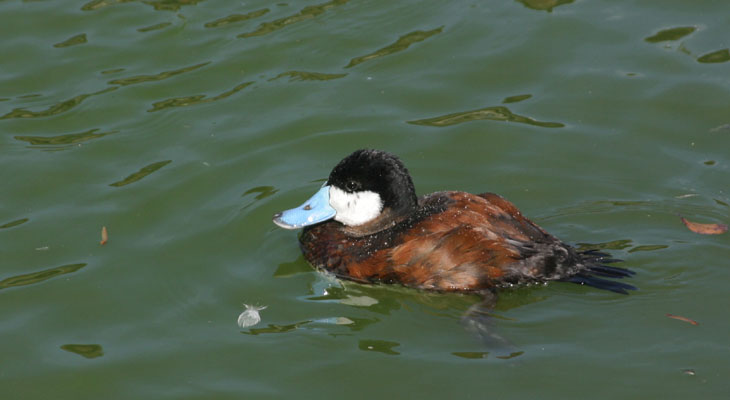























































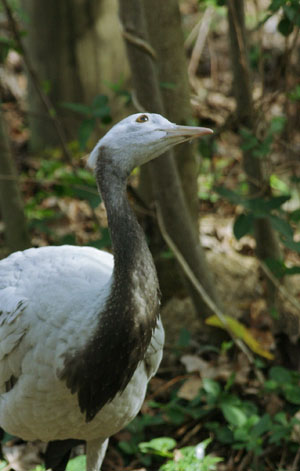 One of the aspects convincing to her of a god, she admitted, was the behavior of some animals. Mother bears protect their cubs, and salmon swim upstream to spawn, where they die, and their bodies nourish the young (I’m just reporting what she told me – I know the current takes away whatever nutrients they might have contributed long before the eggs hatch.) I hadn’t told her that I was a nature photographer and science enthusiast, so she didn’t realize the opening she left me, but I was happy to fill it anyway, with a brief rundown of natural selection.
One of the aspects convincing to her of a god, she admitted, was the behavior of some animals. Mother bears protect their cubs, and salmon swim upstream to spawn, where they die, and their bodies nourish the young (I’m just reporting what she told me – I know the current takes away whatever nutrients they might have contributed long before the eggs hatch.) I hadn’t told her that I was a nature photographer and science enthusiast, so she didn’t realize the opening she left me, but I was happy to fill it anyway, with a brief rundown of natural selection. And so, our saga resumes where it left off, with our heroes trapped within the confines of a completely non-treacherous and non-threatening bird park…
And so, our saga resumes where it left off, with our heroes trapped within the confines of a completely non-treacherous and non-threatening bird park… I’ve spoken before about
I’ve spoken before about  At one point we noticed a local native Wild Turkey (Meleagris gallopavo) hanging out on the outside of the peacock cage, who was only mildly anxious at our approach. A little later we questioned a park worker, who informed us that it was actually a wild fowl, not a park resident, who had taken a shine to the peacocks and turned stalker. I admit to being a little curious over this, since both the peacock and the turkey were males, but I’ve seen territorial disputes between caged and wild birds before, and this situation didn’t have that appearance. (I digress for a brief anecdote: Many years ago while visiting a wildlife refuge in Florida, I saw my first Pileated Woodpeckers, surprisingly large birds, and then checked out the nearby rehabilitation clinic. There, an unreleasable captive who’d had a wing amputation would get apoplectic over a wild visitor, who would periodically sit on the timbers right outside the captive’s fence and beat a territorial drumming, well aware that the resident inside could do nothing about it. And you thought only humans could be sadistic…)
At one point we noticed a local native Wild Turkey (Meleagris gallopavo) hanging out on the outside of the peacock cage, who was only mildly anxious at our approach. A little later we questioned a park worker, who informed us that it was actually a wild fowl, not a park resident, who had taken a shine to the peacocks and turned stalker. I admit to being a little curious over this, since both the peacock and the turkey were males, but I’ve seen territorial disputes between caged and wild birds before, and this situation didn’t have that appearance. (I digress for a brief anecdote: Many years ago while visiting a wildlife refuge in Florida, I saw my first Pileated Woodpeckers, surprisingly large birds, and then checked out the nearby rehabilitation clinic. There, an unreleasable captive who’d had a wing amputation would get apoplectic over a wild visitor, who would periodically sit on the timbers right outside the captive’s fence and beat a territorial drumming, well aware that the resident inside could do nothing about it. And you thought only humans could be sadistic…) Despite my desire for some different subject matter on this trip, I yielded to temptation when I found a pair of Wheel Bugs (Arilus cristatus,) a variety of assassin bug, mating on a fence post. Their piercing proboscises, for draining the insides from the other insects that make up their food, are plainly visible from this angle. This past year has been almost entirely dedicated to bug shots, without my intentions – I’ve simply been unable to do enough traveling to provide opportunities for other subjects, and have been milking the local area for everything I can. I probably should begin a bobcat or fox portfolio project…
Despite my desire for some different subject matter on this trip, I yielded to temptation when I found a pair of Wheel Bugs (Arilus cristatus,) a variety of assassin bug, mating on a fence post. Their piercing proboscises, for draining the insides from the other insects that make up their food, are plainly visible from this angle. This past year has been almost entirely dedicated to bug shots, without my intentions – I’ve simply been unable to do enough traveling to provide opportunities for other subjects, and have been milking the local area for everything I can. I probably should begin a bobcat or fox portfolio project…
 Exuberant Skepticism is a book that I picked up out of interest in the topic, and the reputation of author Paul Kurtz, who is the founder of the Center for Skeptical Inquiry, the Council of Secular Humanism, a fellow of the American Association for the Advancement of Science, and a longtime contributor to Skeptical Inquirer magazine – seemed like just my cup of tea. Yet, it defeated me, and after numerous attempts over an extended period of time, I could not finish this book; thus the post title. While I have avoided chastising certain publishers of reviewed books regarding their cover art choices (mostly the complete lack thereof,) this one might have held a hint, as Kurtz looks out from the cover in undisguised contempt of those damn kids on his lawn, daring the potential reader to make any connection to the book’s title.
Exuberant Skepticism is a book that I picked up out of interest in the topic, and the reputation of author Paul Kurtz, who is the founder of the Center for Skeptical Inquiry, the Council of Secular Humanism, a fellow of the American Association for the Advancement of Science, and a longtime contributor to Skeptical Inquirer magazine – seemed like just my cup of tea. Yet, it defeated me, and after numerous attempts over an extended period of time, I could not finish this book; thus the post title. While I have avoided chastising certain publishers of reviewed books regarding their cover art choices (mostly the complete lack thereof,) this one might have held a hint, as Kurtz looks out from the cover in undisguised contempt of those damn kids on his lawn, daring the potential reader to make any connection to the book’s title.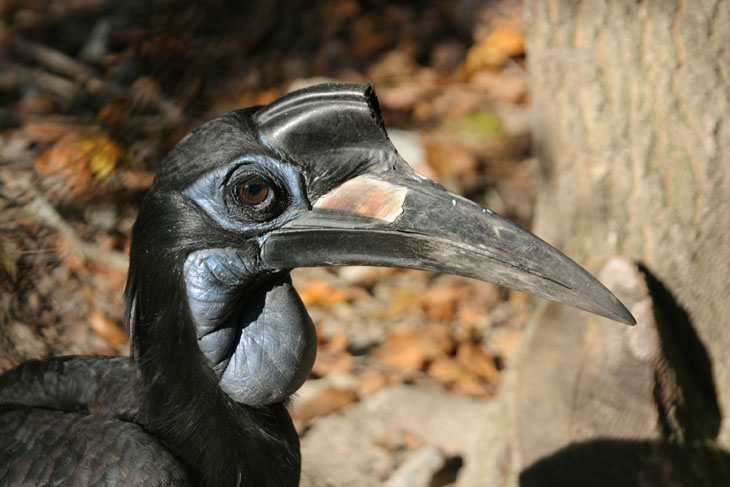
 The first indication of what kind of a day it would be came early on, having entered the park and started out on the deck observing the first pond. While comparing the number of birds, mostly ducks, that were coming up for morning chow, The Girlfriend began making excited attention-getting sounds while being unable to create any actual words. I was trying to remember the procedure for the Heimlich maneuver when I saw what had her attention, which was a young crane eagerly following a park worker up the path like a puppy. The worker heard us, and on return helpfully came over to allow us a closer look. Her companion was a nine-week-old Sarus Crane (Grus antigone), about 80 cm (2 ft) tall and still in the needy stage. That alone probably would have sealed the deal, at least as far as The Girlfriend was concerned, but it was only the start.
The first indication of what kind of a day it would be came early on, having entered the park and started out on the deck observing the first pond. While comparing the number of birds, mostly ducks, that were coming up for morning chow, The Girlfriend began making excited attention-getting sounds while being unable to create any actual words. I was trying to remember the procedure for the Heimlich maneuver when I saw what had her attention, which was a young crane eagerly following a park worker up the path like a puppy. The worker heard us, and on return helpfully came over to allow us a closer look. Her companion was a nine-week-old Sarus Crane (Grus antigone), about 80 cm (2 ft) tall and still in the needy stage. That alone probably would have sealed the deal, at least as far as The Girlfriend was concerned, but it was only the start.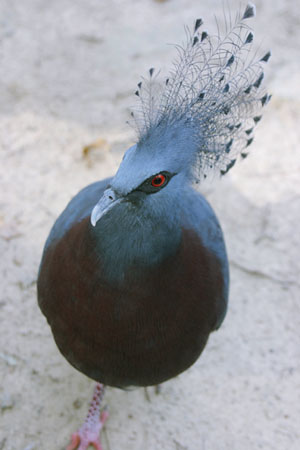 The other side of this coin was the pair of Victoria Crowned Pigeons (Goura victoria) who came up to the fence at our feet and hung out for portraits, then hopped onto the railing to really mug it up, even nibbling on The Girlfriend’s lenshood in the vague hope that Canon had finally made one that was edible (we’ve all been waiting.) There’s always a part of me that’s prepared for the defensive peck or bite, since what appears friendly to us is often intended as a menacing warning sign from birds, but the Vics were totally blasé about our presence. Another Crowned Pigeon, this one alone in a cage nearby, began producing a remarkable call, so bass that it was hard to trace and almost disturbing – I can recommend bringing either a sound recording device or video camera to capture the full range of experience within the park. Also, when shooting digital, be sure to snap the identification signs as you go so you have a record of the species later on.
The other side of this coin was the pair of Victoria Crowned Pigeons (Goura victoria) who came up to the fence at our feet and hung out for portraits, then hopped onto the railing to really mug it up, even nibbling on The Girlfriend’s lenshood in the vague hope that Canon had finally made one that was edible (we’ve all been waiting.) There’s always a part of me that’s prepared for the defensive peck or bite, since what appears friendly to us is often intended as a menacing warning sign from birds, but the Vics were totally blasé about our presence. Another Crowned Pigeon, this one alone in a cage nearby, began producing a remarkable call, so bass that it was hard to trace and almost disturbing – I can recommend bringing either a sound recording device or video camera to capture the full range of experience within the park. Also, when shooting digital, be sure to snap the identification signs as you go so you have a record of the species later on.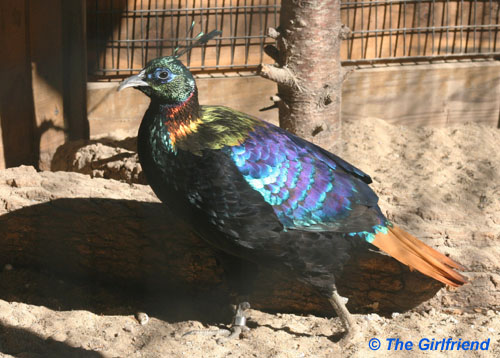 It also provides the opportunity to see some rare and endangered species up close and personal, as well as some really vivid ones, like this startlingly iridescent Himalayan Monal Pheasant (Lophophorus impejanus,) also known as an Impeyan Monal or Danphe. The difference between the male and female (the male shown here) is so drastic as to convince virtually anyone that they are completely separate species. And the nice thing about two people shooting is that one of you can save the ass of the other when they fail to get a decent image, as happened here.
It also provides the opportunity to see some rare and endangered species up close and personal, as well as some really vivid ones, like this startlingly iridescent Himalayan Monal Pheasant (Lophophorus impejanus,) also known as an Impeyan Monal or Danphe. The difference between the male and female (the male shown here) is so drastic as to convince virtually anyone that they are completely separate species. And the nice thing about two people shooting is that one of you can save the ass of the other when they fail to get a decent image, as happened here.
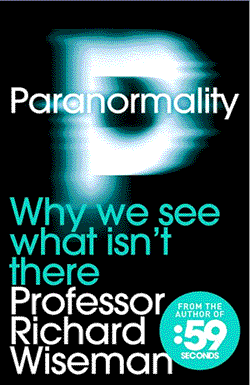

 At left, a visitor just across the road late one night, who knew I was there but wasn’t too concerned – it’s possible to exploit this if you try. Just move slowly but casually, since animals respond more to actions than appearance. Let me put it this way: if you were auditioning for a part in a play and asked to “creep up on somebody,” what would it look like? Usually, exactly what most people do when trying to photograph animals. But the animals recognize this too. If instead, you were asked to “blend in with the crowd and not attract attention,” you’d be heading in the right direction. You’d look off into the distance and seem bored or preoccupied, wander aimlessly, and do anything significant only when no one was looking. You got it.
At left, a visitor just across the road late one night, who knew I was there but wasn’t too concerned – it’s possible to exploit this if you try. Just move slowly but casually, since animals respond more to actions than appearance. Let me put it this way: if you were auditioning for a part in a play and asked to “creep up on somebody,” what would it look like? Usually, exactly what most people do when trying to photograph animals. But the animals recognize this too. If instead, you were asked to “blend in with the crowd and not attract attention,” you’d be heading in the right direction. You’d look off into the distance and seem bored or preoccupied, wander aimlessly, and do anything significant only when no one was looking. You got it.